Fahlman B.D. Materials Chemistry
Подождите немного. Документ загружается.


directions. This might be easier to visualize if one compares the band diagram for a
2-D square lattice, represented as slices through stingray-shaped energy bands along
particular directions of the BZ (Figure 4.11). Normally, only energy bands within
the first BZ are considered since they will be duplicated around the other points of
the reciprocal lattice due to its inherent periodicity. Further complicating the band
diagrams is back-folding of bands that start at other reciprocal lattice points into the
first Brillouin zone. Empirically, band diagrams may be determined using angle-
resolved photoemission, wherein a material is exposed to UV radiation and the
resultant emitted electrons are sorted according to their k-vectors and energies.
[3]
Symmetry labels (e.g., G refers to the center of the BZ (0, 0, 0), X is point (1,0,0),
L is point (1,1,1), etc.) are used on the k-axis to indicate specific BZ points & the
Figure 4.11. Possible energy bands for a 2-D square lattice. The top shows a sketch of the bands
throughout the BZ; energy is plotted vertically. The bottom shows the first two bands along symmetry
lines. Note that the second band at X lies below the first band at W; hence these bands overlap, which is the
case for metals. Reproduced with permission from Harrison, W. A. Solid State Theory, McGraw-Hill:
New York, 1970. Copyright 1970 McGraw-Hill Publishers.
248 4 Semiconductors
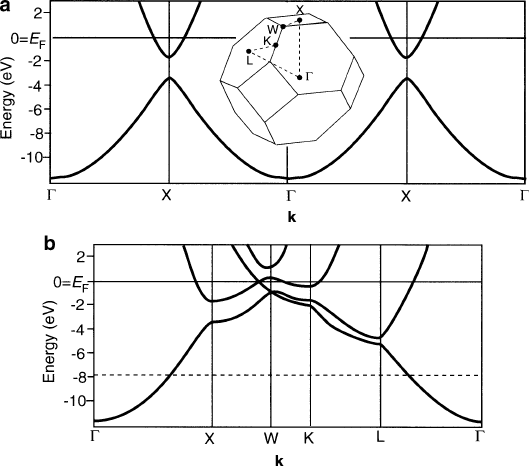
complicated lines indicate the change in valence/conduction band energies as one
traverses thoug h the BZ in certain directions. For instance, Figure 4.12a shows the
BZ and energy band diagram for the fcc Al lattice along the (0,0,0) ! (1,0,0)
direction. Since the Fermi energy (E
F
) lies within the conduction band, this material
exhibits metallic conductivity. As seen in Chapter 2, gaps between bands at BZ
boundaries (e.g., X point in Figure 4.12a ) in the E- k diagram is a consequence of
altering the free-electron model to one that considers the electron within a periodic
lattice potential of a crystalline solid (Figure 4.13). The more detailed band diagram
for Al shown in Figure 4.12b indicates that many bands cross the Fermi level.
Accordingly, electrons in occupied states just belo w E
F
may be excited to states
just above the Fermi level that lie within the same band, giving rise to electrical/
thermal conductivity. Interestingly, the dashed line in Figure 4.12b shows the Fermi
level for a metal with one electron per unit cell such as Na. Rather than being 12 eV
higher than the band bottom, E
F
would lie much lower in energy. Since the bands
cross the E
F
at a uniform k-distance from G in all directions, the band diagram would
be equivalent to the free-electron model, exhibiting a spherical density of states.
Figure 4.12. (a) Electronic energy bands in a metal along the G – X direction only; the inset shows the
first Brillouin zone, BZ, and (b) Energy bands in different directions given by the dashed path between
high-symmetry points of the BZ. The horizontal dashed line is the fictitious Fermi level for a metal with
the same structure, but only one valence electron instead of three. Reproduced with permission from
Hofmann, P. Solid State Physics: An Introduction, Wiley: New York, 2008. Copyright 2008 Wiley-VCH
Verlag GmbH & Co.
4.1. Properties and Types of Semiconductors 249
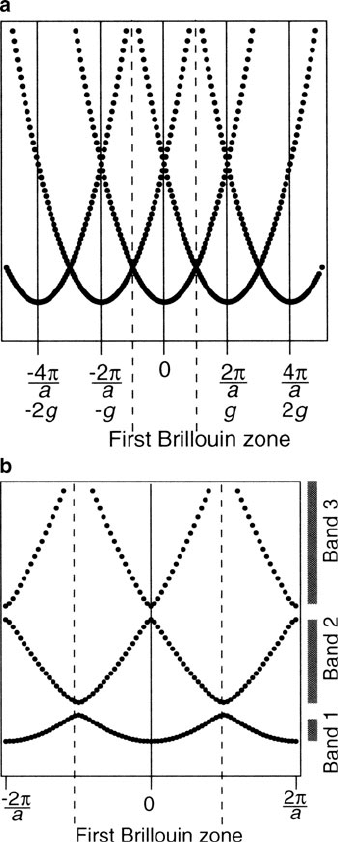
Figure 4.13. Electronic states in the nearly free electron model for a 1-D chain with unit cell length, a.
The energy states in (a) represent solutions to the Schrodinger equation (via the Bloch theorem) with an
infinitesimal potential. In contrast, solution (b) represents a finite lattice potential, which results in the
formation of gaps between the parabolas at the BZ boundary. That is, there is no longer a continuum of
states from the lowest to infinity, but regions where no allowed states may exist. Reproduced with
permission from Hofmann, P. Solid State Physics: An Introduction, Wiley: New York, 2008. Copyright
2008 Wiley-VCH Verlag GmbH & Co.
250 4 Semiconductors
4.2. SILICON-BASED APPLICATIONS
Silicon is the second most abundant element in the earth’s crust, next to oxygen. Due
to the stability of silicon oxide compounds, elemental silicon does not occur in its
free state in nature, but occurs as oxide (e.g., sand, quartz, amethyst, flint, opal, etc.)
and silicate (e.g., granite, asbestos, feldspar, clay, mica, etc.) minerals. The wide-
spread availability of silicon-containing minerals is responsible for the ubiquitous
use of pottery, bricks, glass, and cement since the days of the earliest civilizations.
More recently, the applications for silico n now include electronics. A silicon-
based device is found in almost every consumer product available in our world
today. Even refrigerators now have extensive microprocessor controls, some fitted
with television screens! The popularity of flat-panel televisions has also employed
silicon-based technology, especially for thin-film transistor liquid crystal displays
(TFT LCDs). In addition to electronics, as the world looks for alternative sources of
energy due to dwindling petroleum reserves, silicon-based photovoltaic devices will
represent an increasingly important application for our society.
4.2.1. Silicon Wafer Produ ction
The silicon employed for microelectronic and photovoltaic applications must first go
through extensive processing to ensure that the material is of utmost purity. This
section will describe these steps, with a discussion of perhaps the most int riguing
conversion in the realm of materials science: the synthesis of high-purity polished
silicon wafers from a naturally occurring form of silicon – sand.
Sea sand is primarily compri sed of silicon dioxide (silica), which may be con-
verted to elemental silicon (96–99% purity) through reaction with carbon sources
such as charcoal and coal (Eq. 3). Use of a slight excess of SiO
2
prevents silicon
carbide (SiC) from forming, which is a stable product at such a high reaction
temperature. Scrap iron is often present during this transformation in order to
yield silicon-doped steel as a useful by-product.
The purity of silicon in this first step is only ca. 98%, and is referred to as
metallurgical grade silicon (MG-Si). In order for the silicon to be used for electron-
ics applications, additional steps are necessary to decrease the number of impurities.
Reaction of MG-Si with hydrogen chloride gas at a moderate temperature converts
the silicon to trichlorosilane gas (Eq. 4). When SiHCl
3
is heated to a temperature of
ca. 1,150
C, it decomposes into high-purity silicon and gaseous by-products (Eq. 5).
This reaction is typically performed in a bell-shaped Siemens-type reactor, where Si
is deposited onto heated U-rod silicon filaments. Excess hydrogen gas is also fed into
the reactor, which prevents homogeneous nucleation of Si dust within the reactor.
[4]
SiO
2ðsÞ
þ 2C
ðsÞ
!
20002500
c
Si
ðsÞ
þ 2CO
ðgÞ
ð3Þ
Si
ðsÞ
þ 3 HCl
ðgÞ
!
300
c
SiHCl
3ðgÞ
þ H
2ðgÞ
ð4Þ
4.2. Silicon-Based Applications 251
2 SiHCl
3ðgÞ
!
1150
c
Si
ðsÞ
þ 2 HCl
ðgÞ
þ SiCl
4ðgÞ
ð5Þ
Recently, a fluidized-bed approach has been developed wherein SiH
4
and H
2
gases are fed into the bottom of a vertical reactor held at a temperature >600
C.
[5]
Silicon seed crys tals of ca. 100 mm diameter are suspended in the chamber, and
decomposition of the gaseous precurso r causes the nucleation and homoepitaxial
growth
[6]
of silicon on the surface of the seeds. When grown to large sizes (ca. 1mm
diameters), the particles no longer remain suspended and are collected on a filter at
the bottom of the reactor. The decomposition temperature of SiH
4
is ca. 2/3 that of
SiHCl
3
, but is significantly more pyrophoric and air-sensitive. Relative to the
Siemens process, the fluidized-bed approach represents a smaller system for an
equivalent throughput, while using much less energy. Further, fluidized-bed systems
exhibit greater heat-transfer efficiencies since the gases are heated; in contrast,
Siemens reactors heat only the electrode/growing rod to prevent homogeneous
nucleation of Si on the reactor walls.
These chemical processes result in electronic-grade polysilicon (EG-Si), with a
purity of 99.9999999999%; that is, only one out of every trillion atoms in the solid is
something other than silicon! To put this into perspective, imagine stacking yellow
tennis balls from the earth’s surface to the moon; replacing only one of these with a
blue ball would represent the level of impurities in EG-Si. Every year, ca.
100,000–200,000 mt of EG-Si is manufactured throughout the world for an ever-
increasing number of applications.
[7]
Though the purity of EG-Si is suitable for electronics applications, the atomic
structure must first be converted from its polycrystalline structure (polysilicon)toa
single crystal. There are two main methods used for this conversion: Czochralski
(CZ; Figure 4.14) and float-zone (FZ; Figure 4.15) techniques. For CZ growth,
silicon and any desired dopants are molten together in a crucible at a temperature
above the melting point of silicon, 1,414
C. A rod fastened with a single crystal of
silicon is positioned on the surface of the melt, and is pulled upward while rotating.
This results in a long cylinder of Si that is referred to as an ingot. Due to the surface
tension of the liquid, a thin film of silicon first forms on the seed crystal surface.
Additional silicon atoms orient themselves to the seed crystal; hence, the final ingot
has the same crystal lattice as the original seed. The diameter of the resulting ingot
may be finely controlled by manipulating the temperature and rate of pulling/rotation.
In order to ensure high purity of the ingot, this process is normally performed
in vacuo (ca.10
6
Torr), or under an inert atmosphere (e.g., 99.999% Ar) using an
inert chamber such as quartz. Even under these reaction conditions, the CZ method
technique suffers from O and C impurities that arise predominantly from the
crucible walls. It should be noted that small quantities of O impurities are actually
desirable, as they may trap unwanted transition metal impurities, a process referred
to as gettering. The CZ technique is especially useful to yield doped semiconduc-
tors. For example, to yield p-doped Si, the desired concentration of pure Ga metal is
added to molten Si within the crucible.
252 4 Semiconductors
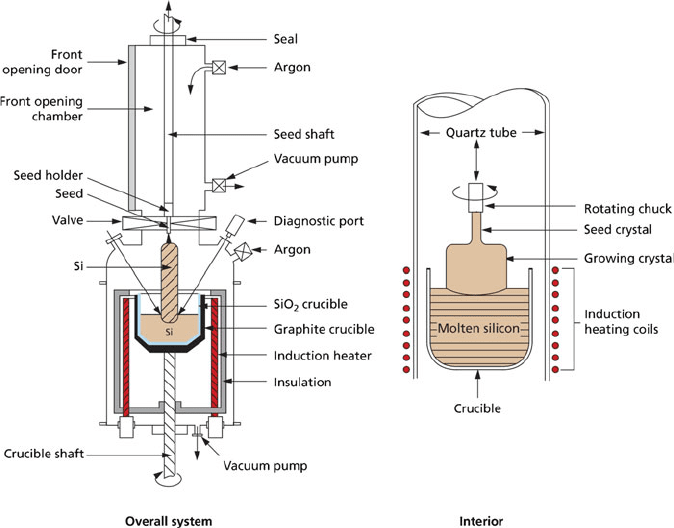
The float-zone technique uses inductive heating to convert poly-Si into
single-crystal ingots of EG-Si. As a heating coil is slowly passed from one end to
the other, the impurities become concentrated in the moving molten zone, becoming
concentrated at the finishing end of the cylinder (Figure 4.15). The resultant cylinder
is typically of greater purity than those using CZ growth, making this technique the
most heavily used for modern semiconductor processing. The single-crystal ingot is
sliced into thin wafers using a diamond saw, with resultant thicknesses of ca.
0.7 mm, and diameters of 300 mm. The crystal orientation and doping (n- or
p-type) of the wafer are designated by the loca tion of primary and secondary flats
(Figure 4.16).
The wafer surface must be free of topographic defects, microcracks, scratches,
and other residual surface imperfections. To ensure that the wafers remain free from
dust and other airborne contaminants, the finished wafers are only handled within a
clean room . To control the particulate contamination, cle an rooms exhibit extensive
use of stainless steel, perforated floors and ceiling tiles to promote air circulation,
and sloped surfaces to avoid dust accumulation. Yellow lighting is used to prevent
light-sensitive material from being exposed to UV light, until desired as a part of
chip fabrication (vide infra). Prior to entering the clean room, personnel must cover
Figure 4.14. Schematic of a Czochralski apparatus used to grow single-crystal Si ingots. Reproduced
with permission from Clemens, J. T. Bell Labs Tech. J. 1997, 76. Copyright 1997 Wiley-VCH.
4.2. Silicon-Based Applications 253
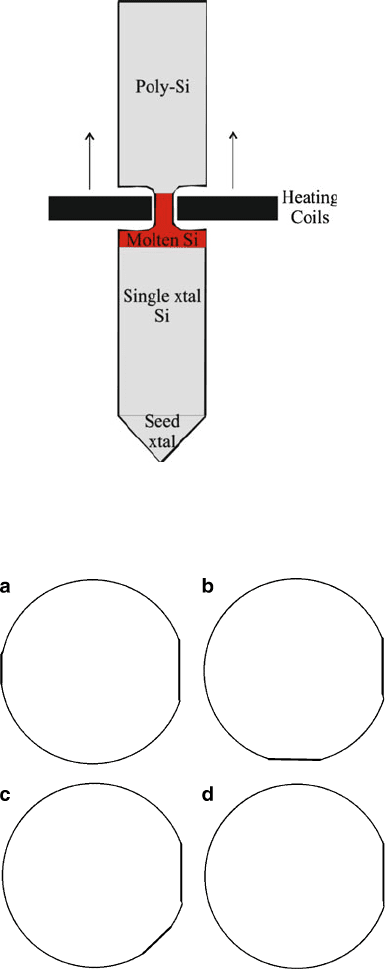
Figure 4.16. Position of flats on Si wafers, used to identify the crystalline plane and type of dopants (n- or
p-type). Shown are (a) n-type (100) – 1
and 2
flats 180
apart, (b) p-type (100) – 1
and 2
flats 90
apart,
(c) n-type (111) – 1
and 2
flats 45
apart, and (d) p-type (111) – 1
flat only.
Figure 4.15. Illustration of the float-zone (FZ) method used to convert a polysilicon ingot into single-
crystal silicon.
254 4 Semiconductors

their clothing with a white “bunny suit” made of Tyvek
®
, a polymeric nonwoven
fabric that exhibits non-lin t and antistatic prope rties, and contains few surface sites
for particulate adhesion (Figure 4.17). En route to the clean room, the worker must
also walk over a sticky pad and pass through an air shower to remove dust particles
from shoes and clothing. The ratings of clean rooms range from Class 1 to Class
10,000 – an indication of the number of particles per cubic foot. As a familiar
reference, in uncontrolled environments such as a typical h ome or office, the particle
count is 5 million per cubic foot!
4.2.2. Integrated Circuits
An integrated circuit (IC), or chip, represents the brains behind all electronic
devices. An IC is a compilation of billions of complex subunits such as transistors,
resistors, capacitors, and diodes that are all interconnected in a specific manner
depending on the desired application. Incredibly, this minute world of microcir-
cuitry is fitted onto the surface of a thin silicon substrate about the size of a grain of
rice (Figure 4.18)! Though ICs have only been used since the early 1970s, consider
some of the ways our lives have been changed:
Lightweight laptop computers are easily taken with us while traveling;
Cars monitor their emissions and adjust engine conditions for maximum
gasoline efficiency;
Doctors are able to operate on patients from remote locations;
Answers to virtually all questions we may pose are available within minutes
via the Internet;
Televisions may be mounted on walls, with a clarity that rivals viewing
through a window;
Figure 4.17. The evolution of semiconductor clean rooms from 1968 (left) to the present (right). Photos
reproduced with permission from Intel Corporation (http://www.intel.com).
4.2. Silicon-Based Applications 255
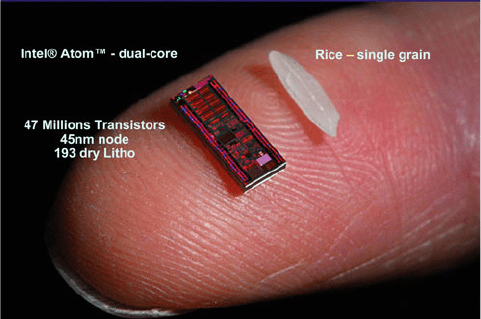
Phones may be used from virtually anywhere on Earth to keep in touch or
check email;
GPS systems tell us how to best arrive at our desired destination...
... What a world we live in – what will the next 50 years bring?...
Field-effect transistors: structure and proper ties
The workhorses of ICs are transistors, which act as electronic switches in digital
circuitry. Transistors were discovered by Bell Labs in the late 1940s as a replacement
for vacuum tubes, which were much larger and consumed significantly more power.
The earliest ICs utilized individual transistors; however, these circuits quickly became
too large and complex to assemble for all but the simplest applications. In particular,
computations were slow due to the long distances traversed by the electrical signals. It
was clear that the only way to make ICs behave faster was by increasing the density of
transistors. In 1965, Gordon Moore (a co-founder of Intel) predicted that the number of
transistors on a chip would double every 2 years. Moore’s Law has been upheld since
this early prediction, with an impressive rise in the number of transistors used in ICs
from the first commercial release in the early 1970s, to the latest multi-core processors
that run both PC and Mac systems (Figure 4.19).
The first applications for transistors were radios, which utilized a small number
(i.e., <10) of transistors. It is hard to believe that current microprocessor chips, with
a package size of 500–800 mm
2
, now contain over a billion of individual nanoscopic
transistors!
[8]
Such a technological advancement is only possible through an expo-
nential decrease in the price of single transistors. For instance, the first commercially
available transistor was the Raytheon CK703, priced at $18 in 1951. Taking inflation
into account, the price of a single transistor would be ca. $120 today, resulting in
computers that would be worth over $100 billion! Fortunately, developments in chip
Figure 4.18. Dimensions of the Intel AtomTM dual-core processor, relative to a single grain of rice.
Photograph reproduced with permission from Intel Corporation (http://www.intel.com). May be accessed
online at: http://www.semi.org/cms/groups/public/documents/web_content/ctr_030805.pdf.
256 4 Semiconductors
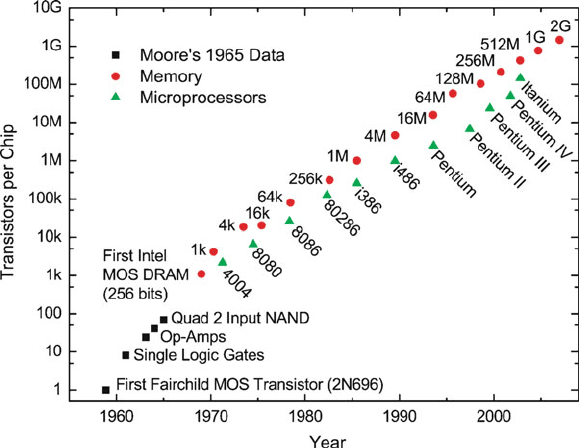
fabrication processes have made it possible to reduce the production costs for a
single transistor to less than $0.000001.
The number of transistors within an IC is typically used to classify the complexity
of the circuits. For instance, the earliest ICs of the early 1960s were considered
small-scale integration (SSI), since they contained fewer than ten transistors. In the
late 1960s, ICs contained between 10 and 100 transistors, referred to as medium-
scale integration (MSI). Large-scale integrated circuits (LSI), containing 100–1,000
transistors, were prevalent in the early 1970s, responsible for the first handheld
calculators. The 1980s brought about very large-scale integration (VLSI), in which
ICs contained more than 1,000 transistors. Although the current architecture s with
greater than 1 million transistors are often referred to as ultralarge-scale integration
(ULSI), the semiconductor industry still considers the latest ICs as being VLSI.
Though integrated circuits are our current means for calculations, this paradigm will
likely not be the last. As developments in nanotechnology continue, alternative
technologies will likely replace transistor-based ICs (e.g., magnetic nanostruc-
tures
[9]
), securing Moore’s Law well into the future (Figure 4.20).
The most important component within all transistors is the p–n junction, referring
to the interface between p- and n-type Si. This contact results in a concentration
gradient being established, where the density of electrons on the n-doped side is much
greater than in the p-doped region (vice versa for the hole concentration). As a result,
free electrons from the n-type Si readily diffuse to the p-doped Si nearest the p–n
junction. A significant number of free electrons will recombine with holes in the p-Si
Figure 4.19. The number of transistors employed within memory and processor chips, relative to Moore’s
Law. Reproduced from Walters, R. J. Silicon Nanocrystals for Silicon Nanophotonics, Ph.D. thesis,
California Institute of Technology, 2007.
4.2. Silicon-Based Applications 257
